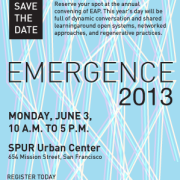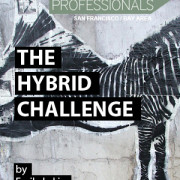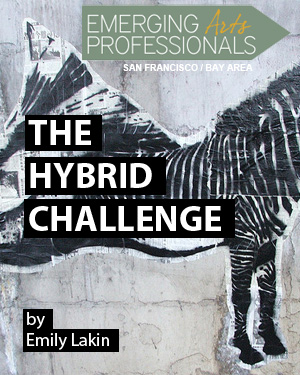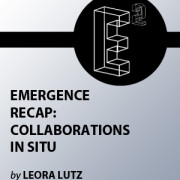Emergence 2013: A Day of Uncommon Learning with EAP
 Join Emerging Arts Professionals / San Francisco Bay Area on June 3 at 10:00 a.m. at SPUR Urban Center for Emergence, our daylong annual convening.
Join Emerging Arts Professionals / San Francisco Bay Area on June 3 at 10:00 a.m. at SPUR Urban Center for Emergence, our daylong annual convening.
Emergence provides a collaborative platform for Bay Area arts and culture workers to connect, share ideas, and elevate their work and voices.
This, our third year, revolves around three overarching themes calling for attention: open systems: talking diversity beyond butts-in-seats, networked approaches: the power of collaboration, and regenerative practices: how individuals and organizations sustain themselves.
We’ve reached out to our community to gather thoughts on these topics — thoughts informing the flow of conversation throughout the day. Shaking up the typical conference model, Emergence presents an experience to engage and energize. Learning will unfold in many directions, demanding your input while sparking new ideas.
From the interactive morning keynote to an afternoon yoga break to the final session — a “fishbowl” exercise to synthesize the day’s ideas and lessons — you’ll be stimulated and renewed. Reflecting the very themes we’ll discuss during the day, sessions are designed to be multi-perspective, participatory, and restorative. As a group, we’ll capture emerging ideas to inform our plans for the year ahead while reflecting on and celebrating the work of our outgoing fellows.
Register today! Space is limited.
Tickets are $40 with 50% discount volunteer rate available. To inquire about volunteer opportunities, email adam [at] emergingsf [dot] org.
Emergence Schedule
9:30 AM – REGISTRATION AND BREAKFAST
10:00 AM – COLLABORATIVE KEYNOTE
Frances Phillips, program director, Arts and the Creative Work Fund, Walter and Elise Haas Fund
Favianna Rodriguez, artist and organizer
Ernesto Sopprani, EAP director of community engagement, founder director of the [ABC] Consortium and THEOFFCENTER
Gregory Stock, public programs educator and event specialist, Fine Arts Museums of San Francisco
11:00 AM – BREAKOUT SESSIONS
NETWORKED APPROACHES – BRIDGING THE ARTS AND TECH SECTORS
Brianna Haag, SF marketing manager at Eventbrite
Emma Leggat, head of Corporate Social Responsibility at StubHub
Alison Murdock, VP of Marketing at GigaOM and board member at Music in Schools Today
Facilitated by Maura Lafferty, independent PR consultant
DEFINING OPEN SYSTEMS, DIVERSITY, REPRESENTATION, AND EQUITY
Lynn Johnson, co-Founder/CEO, Glitter & Razz Productions
Tammy Johnson, dancer and organizational equity consultant
Ron Ragin, program officer for the arts, William and Flora Hewlett Foundation
Clare Winterton, executive director of the International Museum of Women
Facilitated by Karena Salmond, EAP fellow & program director, Performing Arts Workshop
PERSONAL REGENERATIVE PRACTICES
Emma Bailey, Associate Producer, Citizen Film, Co-Host, Spokespeople
Carrie Blanding, former executive director of San Francisco Contemporary Music Players
Yesenia Sanchez, coach and consultant
NOON LUNCH BREAK
1:15 PM – BREAKOUT SESSIONS
OPEN SYSTEMS: PATHS FORWARD
Facilitated conversation
NETWORKED APPROACHES: COMMUNITY ENGAGEMENT
Awele Makeba, producer of free performance series by Magic Theatre at Laney College
Rebecca Novick; director of the Triangle Lab (Intersection for the Arts & Cal Shakes)
Facilitated by Arielle Julia Brown, EAP fellow & theatre teaching artist, Destiny Arts Center & artistic director, The Love Balm Project
PROFESSIONAL REGENERATIVE PRACTICES
Facilitated conversation
2:15 PM – COFFEE AND YOGA BREAK
Yoga with Julie Potter, Senior Program Manager at the Yerba Buena Center for the Arts
3:00 PM – FISHBOWL SESSION
Facilitated by Adam Fong, director of EAP & executive director of Center for New Music
4:00 PM – RECEPTION
Speakers and Facilitators
Carrie Blanding, former executive director of San Francisco Contemporary Music Players
Arielle Julia Brown, EAP fellow & theatre teaching artist, Destiny Arts Center & artistic director, The Love Balm Project
Adam Fong, director of EAP & executive director of Center for New Music
Brianna Haag, SF marketing manager at Eventbrite
Clara Hatcher, president & co-founder, Bay Area Emerging Museum Professionals
Lynn Johnson, co-Founder/CEO, Glitter & Razz Productions
Tammy Johnson, dancer and organizational equity consultant
Maura Lafferty, independent PR consultant
Emma Leggat, head of Corporate Social Responsibility at StubHub
Lex Leifheit, executive director, SOMArts Cultural Center
Awele Makeba, producer of free performance series by Magic Theatre at Laney College
Alison Murdock, VP of Marketing at GigaOM and board member at Music in Schools Today
Rebecca Novick, director of the Triangle Lab (Intersection for the Arts & Cal Shakes)
Frances Phillips, program director, Arts and the Creative Work Fund, Walter and Elise Haas Fund
Julie Potter, program assistant, Community Engagement and Performing Arts, Yerba Buena Center for the Arts
Ron Ragin, program officer for the arts, William and Flora Hewlett Foundation
Favianna Rodriguez, artist and organizer
Karena Salmond, EAP fellow & program director, Performing Arts Workshop
Yesenia Sanchez, coach and consultant
Ernesto Sopprani, EAP director of community engagement, founder director of the Arts Building Consortium and THEOFFCENTER
Gregory Stock, public programs educator and event specialist, Fine Arts Museums of San Francisco
Sean Waugh, assistant to the director of artistic administration, SF Opera
Clare Winterton, executive director of the International Museum of Women
Tyese Wortham, program associate, cultural equity grants, San Francisco Arts Commission
To see what Emergence is all about, read the recaps from last year’s convening.
SPUR Urban Center
654 Mission Street (between 2nd and 3rd)
San Francisco, CA 94105
Join our collaborative Notepad by clicking the image below








